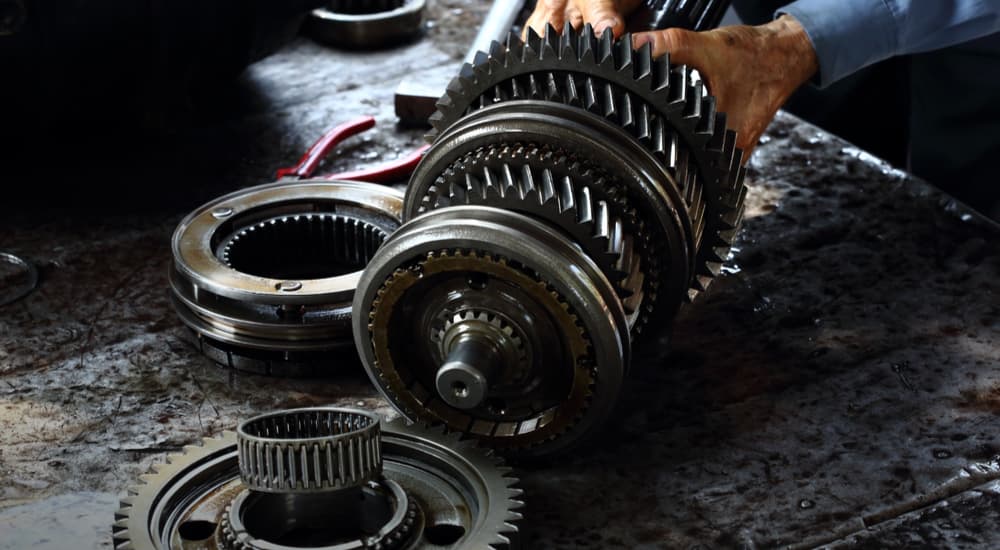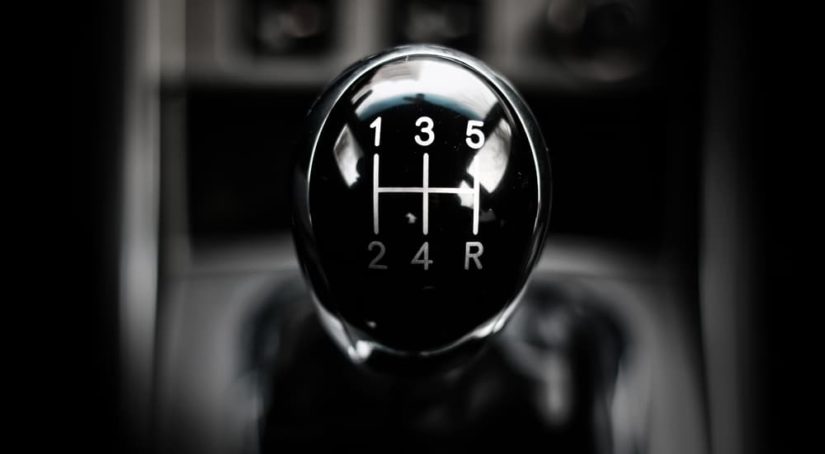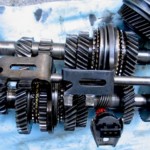When the Ford Model T hit the roads in 1908, it came with a 2-speed transmission. Today, Ford equips models from the Mustang to the F-150 with a 10-speed transmission. Ford isn’t alone in pursuing the proliferation of gears either. Toyota has introduced its own 10-speed for the new Tundra, and Honda has even designed an incredibly compact 10-speed gearbox for use in front-wheel drive models. With seemingly every manufacturer getting in on the game, there must be a reason, but what does having more gears mean for you, the consumer?
What Does a Transmission Do?
The transmission is a vital part of a vehicle’s powertrain. The average internal combustion engine only produces useful power from around 1,000 to 6,000 RPM. Below 1,000 RPM, the engine has very little power and will begin to lug, while above 6,000 RPM, the engine will start to tear itself apart. Although some special engine designs can rev much higher (a Formula 1 engine can reach an astounding 12,000 RPM, although it will wear out after just a few thousand miles), even the highest-revving engines have a relatively limited range compared to the wide variety of speeds a car is expected to operate at.
For instance, if we assume a car can travel 5 mph when the engine is rotating at 1,000 RPM, then the car would top out at just 30 mph when the engine hits its 6,000 RPM limit. This is where the transmission comes in. Taking the same example, if you could shift into a second gear that drops the engine back down to 1,000 RPM when you hit 30 mph, then your car can now reach 60 mph before the engine again redlines at 6,000 RPM. Repeat the process with a third gear, and you can now travel at 90 mph, and so on.
In the real world, transmission gear ratios are designed so that there is a lot more overlap than this because engines are generally happiest when they are not operating at the extremes of their rev range. In fact, most automatic transmissions are designed to keep the engine in the bottom half of the rev range. Still, even if you do not have to rev the engine to redline before shifting gears, it doesn’t take more than a handful of gear ratios to cover the full range of speeds you will encounter in your daily life. Generally, a 4-speed or 5-speed transmission is sufficient to provide a pleasant driving experience.

Why Add More Gears?
If four or five gears is enough to cover any reasonable driving scenario, why have manufacturers moved to 8-speed, 9-speed, and even 10-speed gearboxes? The primary reason is efficiency. Government emissions and fuel economy regulations are becoming more strict by the year, and adding gear ratios helps manufacturers meet them. The ultimate expression of this is the Continuously Variable Transmission (CVT), which has an effectively infinite number of gear ratios, although it is not as rugged as a traditional geared transmission. While the CVT is still common on compact cars and hybrids, the traditional geared transmission has remained relevant through the addition of more gear ratios.
If you are wondering how adding more gear ratios helps a car meet fuel economy standards, the answer is relatively straightforward. Every engine has an ideal engine speed for maximum efficiency, and the closer you can keep the engine to that ideal speed, the less fuel you will burn. The more gear ratios in your transmission, the higher the likelihood that one of those gear ratios will allow the engine to run at its ideal speed no matter your road speed. Having more gears available also means that your engine won’t have to rev too far above its ideal speed before shifting gears as you accelerate.
Performance Benefits of More Gears
While nearly everyone enjoys the idea of burning less gas, not everyone is attracted to optimizing efficiency and keeping their engine constrained. Fortunately, adding gear ratios has real benefits even if you are shopping for a work truck or a performance car. While lots of gear ratios can be used to keep an engine running at its most efficient speed, they can also be used to keep an engine squarely in its powerband for maximum acceleration or improved towing performance. In fact, a large number of gears in modern automatic transmissions have helped contribute to the death of the manual transmission in performance applications.
Perhaps the most obvious example of the performance benefits that come from added gears is the Ford Mustang. Up until 2017, the Mustang was offered with either a 6-speed manual or a 6-speed automatic, but in 2018, the automatic was upgraded to Ford’s new 10-speed gearbox. The engine lineup was also changed, so an apples-to-apples transmission comparison isn’t possible, but a comparison between the automatics and the manual is revealing. While the two 6-speed gearboxes put down effectively the same numbers, the 10-speed is a good half-second faster to 60 and on the quarter-mile than the manual option.
More Gears, More Capability
An additional advantage of adding more gears to a transmission is that it enables the vehicle to have a wider gear range as well as a gear range with more steps. By increasing the 1st gear ratio, the transmission can add more torque when starting off, and by decreasing the top gear ratio, the transmission can lower engine RPMs at highway speeds. The end result is a vehicle that is more responsive at low speeds and quieter at high speeds. The wider gear range can also have special benefits for activities such as towing and off-roading, as it reduces the need for higher final drive ratios.
As an example, take the 10-speed transmission in the current F-150 and the 6-speed unit that it replaced. The lowest gear ratio in the 6-speed was 4.17:1, while the highest gear was 0.69:1. In the 10-speed transmission, the lowest gear ratio is 4.69:1, and the highest is 0.63:1. That effectively means that the standard 3.15 rear axle in the current F-150 is equivalent to a 3.55 axle in the old F-150. And unlike throwing a higher axle ratio into the old truck, it won’t suffer at highway speeds. In fact, once you get up to the top gear, it feels like having a 2.88 rear axle, making the ride quieter and more efficient.

How Many Gears Can You Get?
While there have been patents for transmissions with up to 11 gears, a 10-speed gearbox is the best you will find at your local car dealer. And although adding more gears to a transmission comes with numerous benefits, not every manufacturer has caught up yet. Currently, rear-wheel drive models tend to offer more gears since they have more flexibility to fit larger transmissions and tend to have higher price tags that can better absorb the costs of the more complex gearboxes. However, larger front-wheel drive vehicles are starting to catch up. Interestingly, several of the luxury brands are a little late to the game after focusing development on quick-shifting dual-clutch transmissions rather than increasing the number of gears.
Ford and GM were the first manufacturers to offer a 10-speed transmission, although they needed to pool their resources to develop it. This 10-speed unit was introduced on the 2017 F-150 and 2017 Camaro, and it is now available for almost every rear-wheel drive model from Cadillac, Chevy, Ford, GMC, and Lincoln. When it comes to front-wheel drive models, Ford uses 8-speed transmissions, while GM uses a combination of 9-speed gearboxes for larger vehicles and CVTs for smaller models.
The third member of the Big Three was left out of the joint Ford-GM transmission but has still moved most of its lineup to fairly modern transmissions. Some front-wheel drive Chrysler and Jeep models now use 9-speed transmissions sourced from ZF, starting with the Pacifica in 2017, but the majority of the Chrysler, Jeep, Dodge, and Ram models use older 8-speed transmissions, including all of the rear-wheel drive models. This seems unlikely to change soon as the new Grand Cherokee and Wagoneer both use 8-speed units.
When it comes to imports, Honda has led the way, introducing the first 10-speed transmission for front-wheel drive vehicles with the 2018 Honda Odyssey. This transmission has also made its way to most of the Acura line, although the majority of Honda models still use either ZF 9-speeds or CVTs.
Toyota has largely contented itself with a combination of 8-speed transmissions and CVTs, but the new 2022 Tundra has introduced a 10-speed transmission from Aisin. Given Toyota’s preference for proven technology (several Toyota models still use aging 6-speed transmissions), it remains to be seen how quickly this 10-speed will spread across its lineup.
Nissan was an early pioneer of CVT technology and now uses its Xtronic CVTs across virtually its entire lineup. However, it uses 9-speed transmissions for its trucks, the Pathfinder, and the new 2023 Z. Subaru also bet on CVT technology and no longer offers any traditional automatic transmissions.
The luxury brands are surprisingly behind the curve when it comes to adding gears to their transmissions. Mercedes is currently in the lead, with most of its models using a 9-speed transmission, while Audi uses a combination of 8-speed automatics and 7-speed DCTs. BMW also started going down the DCT path, but it has now switched its entire lineup to use an 8-speed gearbox.
Interestingly, Hyundai and Kia have also gone down the DCT path and currently use possibly the largest selection of transmission designs. In their current lineup, you can find 6-speed, 7-speed, and 8-speed DCTs, as well as 8-speed automatics and CVTs. These brands often offer different transmission types on the same model, with more powerful engine options receiving a DCT instead of a CVT or traditional automatic.
The Future of Transmission Technology
While we have seen an explosive increase in the number of gears found in transmissions, it is unlikely that we will see transmission technology evolve beyond the 10-speed gearbox. While adding more gears can optimize engine speed, more gears can also increase mechanical drag and powertrain losses. Further, emissions standards are reaching the point where internal combustion engines are simply incapable of meeting them, pushing manufacturers to develop electric vehicles instead. While some EVs do use transmissions, the much wider powerband of electric motors and lack of government efficiency standards for EVs mean that far fewer gears are needed. For now, however, we can marvel at the engineering that has gone into optimizing combustion engine technology.



